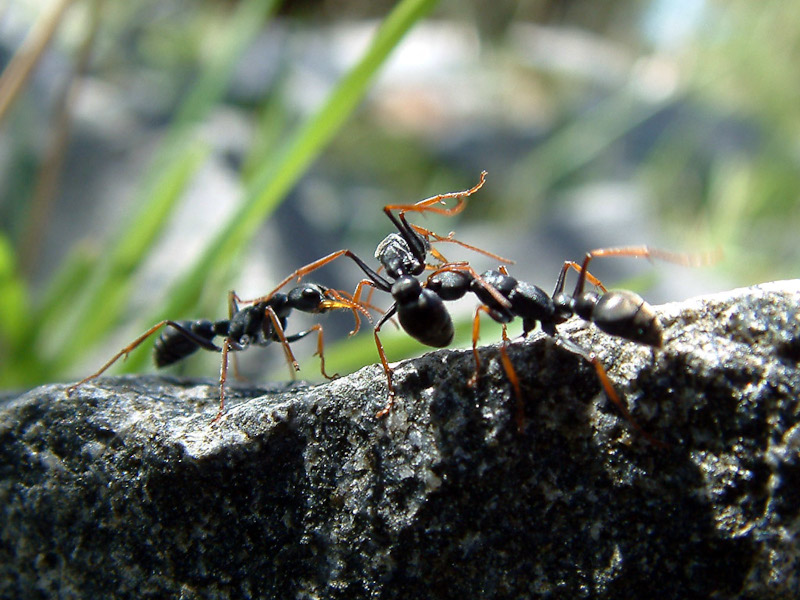
Jack Jumper Ant Facts
- The most often employed common name for this remarkable small invertebrate is the intriguing appellation of the Jack Jumper Ant. It does have a few other general titles, though. Those include the similar tags jumping jack, hopper ant, and jumper ant.
- Inside of scientific circles, however, it’s perhaps better known by its technical moniker. Unfortunately, though, that’s a comparatively difficult one for the average layperson to pronounce. That’s because it holds the official epithet of Myrmecia pilosula.
- The amazing insect received that designation due to the efforts of Frederick Smith. The noted British entomologist accomplished the first acknowledgement of it as a separate and distinct species. He achieved that noteworthy deed in the year 1858.
- The diminutive creature earned many of its general names due to an intriguing physical ability. That’s due to the fact that it has capability of leaping extreme distances relative to its body length. They’re able to jump several times their own body length.
- Thankfully, the fascinating Jack Jumper Ant still continues to maintain both a sizeable and sufficient population base. That pleasant trend further seems to hold true throughout its native range. The IUCN thus currently has no listing for it on its Red List.
- The creature nonetheless faces some potential threats to its existence, at least. As with all life on earth today, most of these occur due to human activities. These dangers include the related perils consisting of habitat loss and ongoing climate change.
Related Articles
Jack Jumper Ant Physical Description
The awesome Jack Jumper Ant represents an impressive creation of time and evolutionary processes. It therefore generally impresses those individuals who encounter it. Yet, it usually doe so for reasons related to both its size and distinctive physical attributes.
Like other ants, it also displays a specific type of the physiological characteristic of sexual dimorphism. It manifests this in caste-based differences, however. This principle does, at least, make identifying the separate castes relatively easy for the trained observer.
Physically smallest of the different stations are the males of the colony. That’s one aspect of sex-based variations displayed by the the species. Mature specimens of this gender only achieve mean body lengths equaling approximately 0.43 – 0.47 in (1.1 – 1.2 cm).
Larger than the males are members of the worker caste. Comprising the largest division numerically, these achieve an average body length typically measuring around 0.47 – 0.55 in (1.2 – 1.4 cm). This societal group consists of females without the ability to reproduce.
Like most ant varieties, the queen reaches the greatest dimensions. For her, an average body length measures about 0.55 – 0.63 in (1.4 – 1.6 cm). Other than her greater size, though, she closely resembles the workers, while both differ from their male counterparts.
All castes of the Jack Jumper Ant have mandibles growing to a mean length of 0.17 in (0.42 cm). Those of males remain smaller and more triangular than on the others. The bodies of all display a mix of black or blackish-red, while the legs usually show orange or yellow.
- Kingdom: Animalia
- Phylum: Arthropoda
- Class: Insecta
- Order: Hymenoptera
- Family: Formicidae
- Genus: Myrmecia
- Species: M. pilosula
Jack Jumper Ant Distribution, Habitat, and Ecology
The intrepid Jack Jumper Ant evolved as native to a moderately restricted portion of the surface of the earth. The precise setting for this zone of habitation likely won’t surprise many people, though. It’s not currently known if the Arthropod ever appeared anywhere else.
This creation of Nature principally inhabits the island of Tasmania, a state of Australia. It also inhabits portions of the mainland, as well. Most of these exist within the southeastern portion of the continent. They include Victoria, Queensland, and New South Wales.
The invertebrate additionally displays moderately broad flexibility regarding its choice of habitat. Most of the places it makes home, though, involve various types of open areas. It also shows a strong sense of favoritism for areas composed of either gravel or sandy soil.
It’s most typically located inhabiting regions of grasslands, dry, open forests, woodlands, and various rural areas. Yet, the wonder doesn’t shy away from other locations, either. That’s because the insect also inhabits sections of pastures, gardens, and even private lawns.
Evolution created the Jack Jumper Ant as primarily diurnal in nature. Throughout most of the day, workers search for food for the colony. It’s highly acctive during the warmer months, but typically goes dormant during the cooler parts of the year in most parts of its range.
The species evolved as omnivorous in terms of its diet. Fauna consumed consists of various small insects, and sometimes even spiders, bees, wasps, and other ants. Flora fed on mainly includes the different sweet substances taken from a variety of locally available plants.
Species Sharing Its Range
Check out our other articles on 4 Fantastic Woody Shrubs of France, Ribbon Seal, Texas Blind Salamander, Sicilian Fir, Halloween Hermit Crab, Eastern Yellowjacket, Rough-nosed Horned-Lizard
